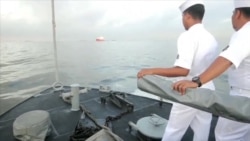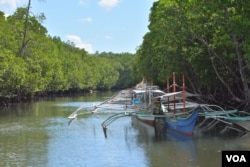In the tiny coastal Philippine town of Bahile in Palawan province, fishermen drop off the night’s catch with the local fish distributor.
On the one main road that bisects the town, fish sorters load plastic tubs with the catch while children play on the shore during the sunny late morning.
But the idyllic scene is set against a back drop of tension and conflict brewing off shore in the South China Sea.
US troops
Here and elsewhere in the Philippines, some who will be directly affected by a recent Supreme Court decision clearing the way for more U.S. troop visits are having mixed reactions.
The increased rotations come at a time when the Philippines is trying to build up its military in the face of growing maritime assertiveness from China.
Nicolas Ellis, a local fisherman, has been living here for more than 25 years and he said he likes this quiet life. Besides, he said, tensions between neighboring countries over who claims what in the South China Sea have not touched this small town.
For decades scores of small fishing boats from Bahile have passed a naval station along the way to Ulugan Bay, less than a kilometer away. But in the past year or two, Ellis said, going to Ulugan has been nerve-wracking.
The Philippines’ two Hamilton-class cutters that were converted into its largest warships patrol the country’s South China Sea shores and dock near a planned outpost in Oyster Bay, inside Ulugan.
Affects fishermen
Ellis said it happens about once a month and small boats cannot get near.
“They should give us a passageway,” he said. “Of course if the ship suddenly shines a light on you, you feel like, ‘Why are you doing this? We are not bad people. We haven’t done anything wrong.’”
But military activity in the area is expected to increase.
In the next year, the Philippines is acquiring a third cutter and a research ship, both from the United States.
And, under the Enhanced Defense Cooperation Agreement approved by the Supreme Court last month, more U.S. troops will visit and house equipment at local bases, including the one planned in Oyster Bay.
The Philippine military has said the United States needs easy access to materiel used during times of disaster, especially in a country battered by an average of 20 typhoons per year.
The U.S. has talked about the need to be here in broader terms, stating the agreement allows the ability to “provide rapid humanitarian assistance” and supports the Philippines military modernization program.
Deterrent to China
But analysts have said having the U.S. military around also serves as a deterrent to China’s increasing assertion of its claim to practically the entire South China Sea. Apart from the Philippines, Brunei, Malaysia, Taiwan and Vietnam also have competing claims in the resource-rich sea.
In the past two years, China has built up contested outcroppings in the sea turning them into artificial islands.
And in recent months the United States has carried out freedom of navigation rotations getting within 12 nautical miles (22 kilometers) of some of the contested outcroppings.
Subic Bay, about 900 kilometers northeast of Bahile, is also anticipating the additional rotations.
The fast-growing international port, where a projected 120,000 containers docked in 2015, has seen its use triple in the past three years, and that trend is expected to continue.
Subic, which once housed a massive U.S. navy base, is still a regular stop for U.S. ships and submarines.
Subic Bay Metropolitan Authority Chairman Roberto Garcia said those visits can contribute up to $500 million per stop to the local economy.
Garcia said there is room for the Philippine warships, while Subic Bay airport, which is largely unutilized, will be a staging ground for military jets. He did not specify whether those would be only for Philippine jets or whether American military aircraft would also be using the space there.
“I could lease it out for large amounts of money, but, well, for me, what’s important is the national security of the country. So I’m willing to forego that,” he said.
But in Bahile, fishermen like Nicolas Ellis said keeping their quiet life is more important than the money that comes with big ships and more troops.












